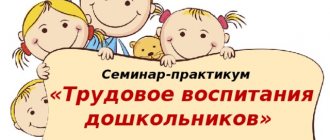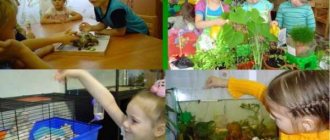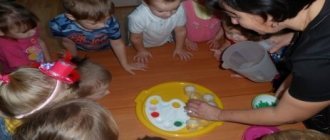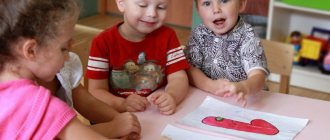CONTENT, TYPES (WORK) OF PRESCHOOL CHILDREN
According to its content, the work of preschool children is divided into four types: self-service, household work, work in nature, manual and artistic work (V. G. Nechaeva, G. N. Godina, D. V. Sergeeva, R. S. Bure, L.I. Zakharevich, etc.).
Self-care is the work of a child aimed at serving himself (dressing and undressing, eating, sanitary and hygienic procedures). The quality and awareness of actions differs among different children, so the task of developing self-service skills is relevant at all age stages of preschool childhood. In younger groups, the teacher shows how to perform actions: how to hold tights, a dress, so that they are comfortable to put on. The demonstration should be step-by-step, with an explanation. You can’t just tell your child: “Here are the tights, take them like this and put them on.” Everything is difficult for a baby: to take it, to stretch the elastic band, and to insert the legs into not one stocking, but two. At first, the adult helps at every stage, and over time gradually reduces the share of his help, support, and hints.
Sometimes you can allow your child to make a mistake and then together analyze the reasons for the mistake. It is very important that the adult is patient and not angry with the child for repeated mistakes. This means that he explained it poorly and did not see what remained incomprehensible to the child. It is very important to praise the child for every success, even the smallest one, on such a difficult path for him to master work skills. Work should always be the joy of achievement for a child, and not a duty and fulfillment of the will of an adult. Otherwise, very soon the child will begin to refuse to perform certain actions. As a result, a conflict arises in which the adult is essentially to blame.
Sometimes, even if the baby has already learned some action, you can “pamper” him: “Let me put a dress on you today, as if you were little.” It should be noted that in cases where the formation of self-service skills is carried out successfully, children, as a rule, refuse help. They like to do everything “like big people,” and the help of an adult offends them. Similar play situations can be accepted by older (4-5 years old) children who sometimes already want to “return to childhood.”
When teaching self-service work, the teacher uses looking at pictures. They are useful in forming ideas about the sequence of actions. It is advisable to use special manuals that help teach children how to fasten buttons and lace shoes (refer to the materials of M. Montessori). You should show your child the correct techniques, introduce him to the “little secrets” that make it easier to perform certain actions (it is better to fasten the buttons on a shirt from the bottom, not from the top, then you can control what you are doing, see the last button and the last loop and connect them).
Toys and puppet theater characters watching and teaching children make the learning process attractive and emotionally rich. Poetic words, songs, and jokes also help the child.
The content of self-care work changes at different age stages and as children master work skills. If a child has mastered the ability to dress independently, he needs to be taught to do it neatly, beautifully, quickly, and to take care of his appearance and hairstyle. Children are taught the habit of taking care of things, not getting dirty, not tearing clothes, and folding them carefully.
The content of self-care work for older preschoolers also includes self-care: preparing the workplace before starting drawing; cleaning and even washing (at home) cups, spoons after meals, making the bed, tidying up toys and books.
Having learned self-service, a child acquires a certain independence from an adult and develops a sense of self-confidence. Of course, even in older preschool age, children sometimes need the help of an adult, but still, before entering school, they should already be able to do a lot on their own.
Household work.
This is the second type of work that a child of preschool age is able to master. The content of this type of labor is cleaning the premises, washing dishes, doing laundry, etc. If self-service labor is initially intended for life support, for taking care of oneself, then household labor has a social orientation. The child learns to create and maintain his environment in an appropriate manner. A child can use his household skills both in self-care and in work for the common benefit.
Household work is the activity of adults that is most accessible to a child’s understanding. When children watch an adult, they have a desire to imitate and do everything “like mom”: wash the dishes, sweep, do laundry. You should never refuse a child. And although at first his actions bear little resemblance to work, the participation of an adult in the work makes them attractive to the baby. These actions become labor when the child makes an effort and achieves some result.
Household work for children of younger groups consists of helping an adult in wiping furniture, arranging toys, washing small items, removing snow from the area, decorating the area, etc. In the process of such work, the teacher develops in children the ability to focus attention on one lesson and, with the help of an adult, to complete the task. Positive assessment and praise are very important.
Children of middle and senior preschool age are capable of more varied household work and need less help from an adult. They can clean the group room (wipe dust, wash toys, arrange light furniture), the area (shovel snow, remove leaves); take part in the preparation of food (salads, vinaigrette, dough products), in the work of repairing books, toys, clothes.
Gradually, children acquire independence in this type of work. The teacher uses methods of showing, explaining, discussing the work process and results, evaluating, teaching certain methods of performing labor operations (how to wring out a rag so that water does not flow down the sleeves, etc.). It is important to form in preschoolers an idea of the importance of household work for everyone and for everyone personally. It is this work that makes it possible to show the child that he himself can make the environment in which he lives beautiful and pleasant. The teacher always draws the children's attention to this side. If each of us cares about making everything around us beautiful, we will not be able to throw a piece of paper on the floor and, of course, will not draw on the wall or in the elevator. Only someone who doesn't love his home can do this. In this way, the ability to notice disorder and eliminate it without an adult’s reminders is developed.
Modern household work is made easier by technology. There is also one in the preschool institution (vacuum cleaner, mechanical brush for washing windows, etc.). At home, many children's families have a washing machine, dishwasher, microwave oven, etc. The child sees how adults use such equipment. It is also useful to teach children to use household machines. At home, a child can vacuum the carpet on the floor and watch the washing machine in action. You just need to be sure to familiarize children with safety rules and try not to leave them alone with equipment. But under the supervision of an adult and together with him, a child can, using equipment, engage in household work.
Practice shows that by older preschool age, some children lose interest in this type of work. The reason is that the child has already mastered the necessary skills. Children do everything that is required of them: wash toys, make beds, etc., but they do it without interest. The content of household work can be complicated by expanding the range of responsibilities or introducing a new object for the use of already developed skills (wiping dust not only in the toy closet, as has always been the case, but also on the windowsill, on furniture in the bedroom).
Household skills acquired by children in preschool are transferred to the family and vice versa.
Labor in nature is distinguished as a special type of labor. The content of such work is caring for plants and animals, growing vegetables in the garden, landscaping the area, participating in cleaning the aquarium, etc. Labor in nature has a beneficial effect not only on the development of labor skills, but also on the education of moral feelings, laying the foundations of environmental education.
In younger groups, children's attention is drawn to plants and animals. The teacher organizes observations of animals and at the same time tries to maintain the interest of the kids. Together with an adult and under his guidance, the child cares for living objects.
The responsibilities of children of senior preschool age are much broader. And this is understandable. The child already knows more, knows more.
Labor in nature has its own characteristics. Let's look at them in more detail.
The result of this work can be a material product ( vegetables grown by the child, a tree planted by him, etc.). This brings child labor closer to the productive labor of adults.
Labor in nature most often has a delayed result: they sowed seeds and only after some time were able to observe the result in the form of seedlings, and then fruits. This feature helps to cultivate endurance and patience.
While caring for animals and growing plants, the child always deals with living objects. Therefore, special caution, careful attitude, and responsibility are needed. The absence of these factors can lead to the death of a living person.
Working in nature makes it possible to simultaneously develop cognitive interests. Children observe the growth and development of living objects, learn about the characteristics of some plants and animals, experiment, learning about inanimate nature.
This type of work gives children the opportunity to bring joy to other people (treat them with grown fruits, give flowers).
Thus, work in nature contributes not only to labor education, but also to moral, aesthetic, mental, and physical development.
Manual and artistic labor, by its purpose, is labor aimed at satisfying the aesthetic needs of a person. Its content includes the production of crafts from natural materials, paper, cardboard, fabric, wood. This work contributes to the development of imagination and creative abilities; develops small arm muscles, promotes endurance, perseverance, and the ability to finish what you start. Children delight other people with the results of their work by creating gifts for them. Artistic work in a preschool institution is presented in two directions: children make crafts and learn to decorate the group room for the holidays with their products, design exhibitions, etc.
Certain elements of manual and artistic labor can be introduced already in younger groups. In this case, the participation of an adult is mandatory. More precisely, children help an adult in creating crafts. And although the activity of children of this age is minimal, involvement in such interesting work is very useful. The child sees how, in the hands of the teacher, a simple stick suddenly turns into a doll, and a ball into the head of a funny clown. This “magic” fascinates children, delights them and motivates them to their own activities.
In relation to preschool age, we can also talk about the emergence of mental work. Any work is characterized by an effort aimed at achieving a result. The result, as we said above, can be materialized (an object made by a child, a grown plant), can be presented through an improvement in quality (washed doll clothes, a cleaned bird cage), or can act as a logical solution to some problem (mathematical , everyday life, the child’s own “discovery” obtained as a result of reflection, etc.). The latter is the result of mental labor. The teacher teaches children to “think before they act,” explain to themselves and others the course of their thoughts, draw conclusions and conclusions, and, finally, receive satisfaction from independently finding a solution (“thought of it”).
Mental labor accompanies (should and can accompany) any other type of child labor if we want it to be performed consciously. It is necessary to instill in children interest and respect for mental work, to show its importance for people and for a particular child. Stories about scientists and inventors help in working with children (this issue is discussed in more detail in the course “Methods of introducing children to social reality”). A child’s mental work has all the structural components of work activity: motive, goal, process, result. It is carried out both during educational activities and in everyday life. Like any other type of labor, it has its own forms of organization.
Interaction between family and kindergarten
Education through labor must be systematic, so parental support in this matter is extremely important. The requirements that are heard at home must fully comply with the requirements for a child in kindergarten.
At parent meetings, it is necessary to introduce mothers and fathers to the educational program of the educational institution. The teacher must advise parents or persons replacing them on the means and methods of organizing child labor at home. It must be remembered that kindergarten lays the foundation for successful labor education at school.
It is useful for parents to organize demonstrations of their pupils’ crafts and drawings. Photo exhibitions are great for this, where they clearly show how kids work, and each photo should be accompanied by interesting explanations. The group should be equipped with thematic stands, exhibitions with recommended books and materials on raising children. It would be good if the positive experience of labor education of individual families was popularized.
Forms and methods of organizing the educational process
In a kindergarten group, children can do the following work, the purpose of which is labor education:
- Orders are the simplest methods. The baby is given a specific task that he completes. The system of individual orders has proven itself well.
- Duty - kids learn to be responsible for the assigned task, to be careful and efficient.
- Common work solves the problems of moral education. It is introduced in senior and preparatory groups.
- Business relationships are built between preschoolers in the process of common work.
What are the main means for instilling a love of work in preschoolers?
The example of adults is the best means of labor education
. Basic means:
- own labor process, which is carried out by preschoolers;
- familiarization with the process of work performed by adults;
- knowledge of the labor process through creativity and artistic development.
So, in the process of labor education, preschoolers should develop the concept of the labor process. Attitude to work and work activity, skills to perform certain types of work appropriate to age.
Preschool teachers and parents must act in cooperation and close cooperation.
How to develop hard work in children
For a child to become hardworking, he must be raised. But the most important thing is that he should experience joy from work.
In a playful way, children gain skills and abilities to work
Child labor is unique:
- in terms of content, the work is simple;
- actions are available;
- connection with game processes.
If you watch children, you can see that for 2-3 years the work of an adult is reflected in the game. Children imitate the actions of their elders. Let your child watch adults doing some work. Kids can wash clothes for dolls, wash soft toys, and finally tidy up their room or children's corner. Children aged 5-6 years, as well as seven-year-olds, already play situational games. Such means are excellent in developing labor skills.
Situational games - a fun method of labor education
The content of a child’s work is similar to the content of an adult’s work. It is important that work is meaningful, brings joy and ignites creative impulses.





